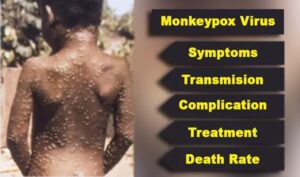People around the world are suffering a lot physically, mentally, financially, and in different fields from the Coronavirus pandemic. Among this pandemic situation, in North Wales of Britain has been reported by two cases of monkeypox infection. Health officials in Wales have expressed concern that both men were infected outside the country. Both patients are currently being monitored and under an investigation into how the infection spread is ongoing. Officials said that the risk of the virus spreading from patients to healthy people is low.
Table of Contents
What is Monkeypox?
According to the WHO, monkeypox is a zoonotic viral disease. This means that the virus is transmitted from infected animals to humans. Most of its cases are found in tropical rainforests in Central and West Africa.
The virus is transmitted to humans through contact with the blood, sweat, and saliva of infected animals. The virus belongs to the group of smallpox that is the Orthopoxvirus genus in the Poxviridae family.
How monkeypox virus is transmitted to humans?
The virus is mainly transmitted to people via wild animals such as rodents, squirrels, Gambian poached rats, dormice, different species of monkeys, etc. It is also transmitted from human to human but it is limited.
It is mostly spread from animals to humans or human to human through lesions, respiratory droplets, body fluids like blood, saliva, sweat, and contaminated things like bedding. Improperly cooked meat and animal products of infected animals are also risk factors.
Congenital monkeypox is also reported in which infection is transmitted from mother to fetus via the placenta.
What is the incubation period of the monkeypox virus?
The incubation period which is the time duration from infection to onset of symptoms of monkeypox is usually 6 to 13 days. But it can range from 5 to 21 days.
What are the symptoms of monkeypox?
Be alert if you notice these symptoms. The symptoms or clinical presentation of monkeypox are similar to those of smallpox. Clinical presentation can be divided into two periods.
In the invasion period, symptoms include fever, headache, back pain, muscle aches, fatigue, generalized weakness, and swollen lymph nodes. All of these symptoms indicate that you may have been infected with the monkeypox virus. Lymphadenopathy is differentiating symptoms of monkeypox from other similar diseases like chickenpox, measles, and smallpox.
The other period is the skin eruption period. The British health agency NHS says that rashes appear on the skin within 1 to 5 days of infection. This is its initial feature. It starts from the face. Gradually, such rashes appear on other parts of the body as well. The rashes mostly more appear on the face and extremities than on the trunk. Initially, the rashes are in macule form and evolve to papules. Gradually it is filled with fluid and pus which is known as vesicles and pustules.
What are the complications of monkeypox?
Monkeypox lasts usually for 2 to 4 weeks. Children are more prone to severe forms of the disease. Secondary infections, sepsis, encephalitis, bronchopneumonia, a corneal infection that may lead to loss of vision, etc. are some of the complications of the disease.
How to diagnose monkeypox?
History taking and diagnosis from symptoms are most important. Its rashes should be differentiated from chickenpox, measles, smallpox, bacterial skin infections, scabies, syphilis, and allergic rashes related to medications. Lymphadenopathy is a prominent feature of monkeypox.
Polymerase chain reaction (PCR) is one of the tests to diagnose it. Antigen and antibody tests are not advised because it is serologically cross-reactive to other orthopoxviruses and can give false-positive results.
What is the treatment of monkeypox?
No specific treatment is there for the disease. Symptomatic and supportive treatment is mostly done. Some antiviral medicines are prescribed by qualified doctors according to the need and severity of the case.
How to prevent monkeypox infection?
Vaccination against smallpox that is Vaccinia vaccine is also effective in the prevention of monkeypox. At present, the first-generation vaccine for smallpox is not available. A new vaccine is developed and approved to prevent smallpox and monkeypox but it is not widely available in many countries.
Other preventive measures include raising awareness and educating people about the risk factors for the disease. Take all preventive measures to avoid infection from infected animals as well as infected humans. Always eat cooked meat. Health personnel caring for patients need more precautions.
Monkeypox Virus FAQs
When monkeypox virus first detected?
The virus was first identified in the Democratic Republic of Congo in 1970 in a 9-year-old male child. The disease is endemic to this area. Then it slowly spread all over the world. The first case of the virus was reported in the United States in 2003.
Almost 45 years after the last confirmed case, Nigeria faced the largest outbreak of monkeypox in the year 2017
Who discovered monkeypox?
Preben von Magnus first discovered monkeypox in 1958 in the monkey when two outbreaks of a smallpox-like disease were kept for research purposes. But the first human case of the disease was reported in 1970 in the Democratic Republic of Congo (Zaire).
What is the mortality rate for monkeypox?
Generally, people wonders, is monkeypox deadly? According to the WHO, the risk of death in monkeypox cases is 11%. Most of the deaths occur in younger age groups. A vaccine called ‘Vaccinia Immune Globulin’ or vaccinia vaccine is taken to protect against smallpox. The same vaccine is given to the patient as monkeypox also belongs to the same group. Health officials say the risk of the virus transmission from infected patients to healthy people is low.

